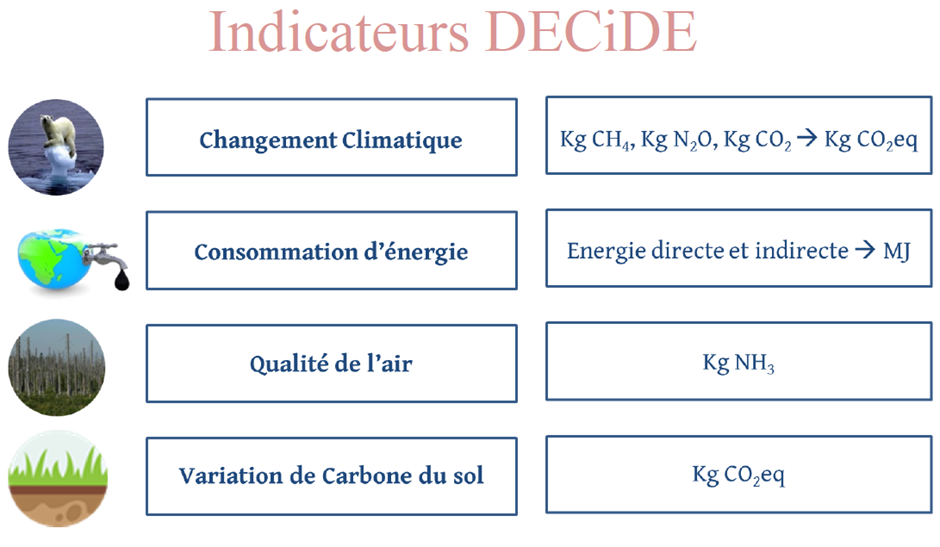Introduction
DECiDE, Energy-Climate Diagnosis of Agricultural Holdings in Wallonia, is primarily intended for farmers and agricultural advisors wishing to carry out the environmental assessment of one or more farms (dairy and beef cattle, field crops, mixed farms). However, it can also be used in the context of research projects involving environmental indicators. DECiDE has the following objectives:
- To enable the estimation of the environmental performance of Walloon farms (dairy, beef, field crops and mixed).
- To quantify and compare the results of the assessments with a group of the same type of farms: impact of practices and production methods, basis for advice
- To highlight and monitor the efforts made by farmers to reduce their impact on the environment.
- Work according to the principles of life cycle analysis (LCA) on a common methodology in Wallonia based on adapted regional data/references
- Produce reliable reference values for decision-makers, research, etc.
- Quantify the services of agriculture for society (C storage, green energy, etc.)
- Evaluate the sustainable nature of our agricultural production
DECiDE is based on the principle of Life Cycle Assessment (LCA), a standardised methodology (ISO 14040), and it allows the environmental impacts of agricultural production to be assessed from the extraction of raw materials to the farm gate.
Description of the innovation
Beef | Parameters | Time needed | Complexity | Complete by | Cost |
Yes | based on the principle of Life Cycle Assessment |
|
| Farmer | Freely available |
What makes this tool different in comparison with other tools?
It is specifically made for Walloon beef farms.
Enteric fermentation
Enteric methane (CH4) is calculated based on an emission factor, the number of animals and the animal category. The emission factor depends on the gross energy supplied from the feed (based on net energy requirements and ration digestibility), the CH4 conversion factor (%GE in rations by cattle category), and the energy value of CH4 (55.65 MK/kg).
Manure management
CH4 emissions from the manure depend on the emission factor for CH4 from farmyard manure in barns (by category of cattle) and the CH4 emission factor from farmyard manure on pasture (by category of cattle).
The emissions factor of manure is based on:
- volatile solids (VS) excretion rate by (fraction of diet consumed undigested and thus excreted as faecal matter)
- CH4 conversion factor (function of the type of farm manure management system) according to the type of manure per cattle category
- maximum CH4 production capacity from farmyard manure by cattle category
- the conversion factor from m³ to kg methane (0.67)
- distribution of dry matter excreted for the different types of manure produced according to the type of animal housing per cattle category
- and the number of days the animals are in the barn (or on pasture)
N2O emissions are calculated based on N input (farmyard manure storage, mineral and organic fertiliser application, leaching, atmospheric deposition) and the emission factor.
The calculation of NH3 emissions follows the recommendations of the European Environment Agency published in the Air pollutant emission inventory guidebook 2009. It is based on nitrogen input, emission factor, and NH3 emission reduction factor according to the method of storage or application of the applied farmyard manure.
Carbon sequestration
Agricultural soils are important components of the global carbon cycle. Changes in the carbon content of soils can lead to significant exchanges of CO2 with the atmosphere depending on how they are managed, and agricultural soils (especially grasslands) as well as natural infrastructure (hedgerows, isolated trees, orchards) can be important carbon sinks (IPCC Tier 2 model, 2006).
The term net carbon footprint is used when the change in carbon stock is taken into account in the overall environmental balance
- Crops: cultivation techniques, based on initial soil C levels and agricultural practice. Input data: Crop areas, postcode, Fertiliser application, soil carbon content (Requasud, 2016), Ploughed areas, presence of intercropping, soil density (Requasud, 2016), crop residue management, areas with land use changes in the last 5 years
- Meadows: areas of permanent grassland
- Hedges: linear length of hedges
- Trees: number of trees
Impact on farm performance
Socio-economic resilience: Only an online registration is needed, to fill in the online tool no cost is charged
Animal health and welfare: AHW is not taken into account in this tool
Production efficiency and meat quality: PEMQ is not taken into account in this tool
Environmental sustainability: Explained above
